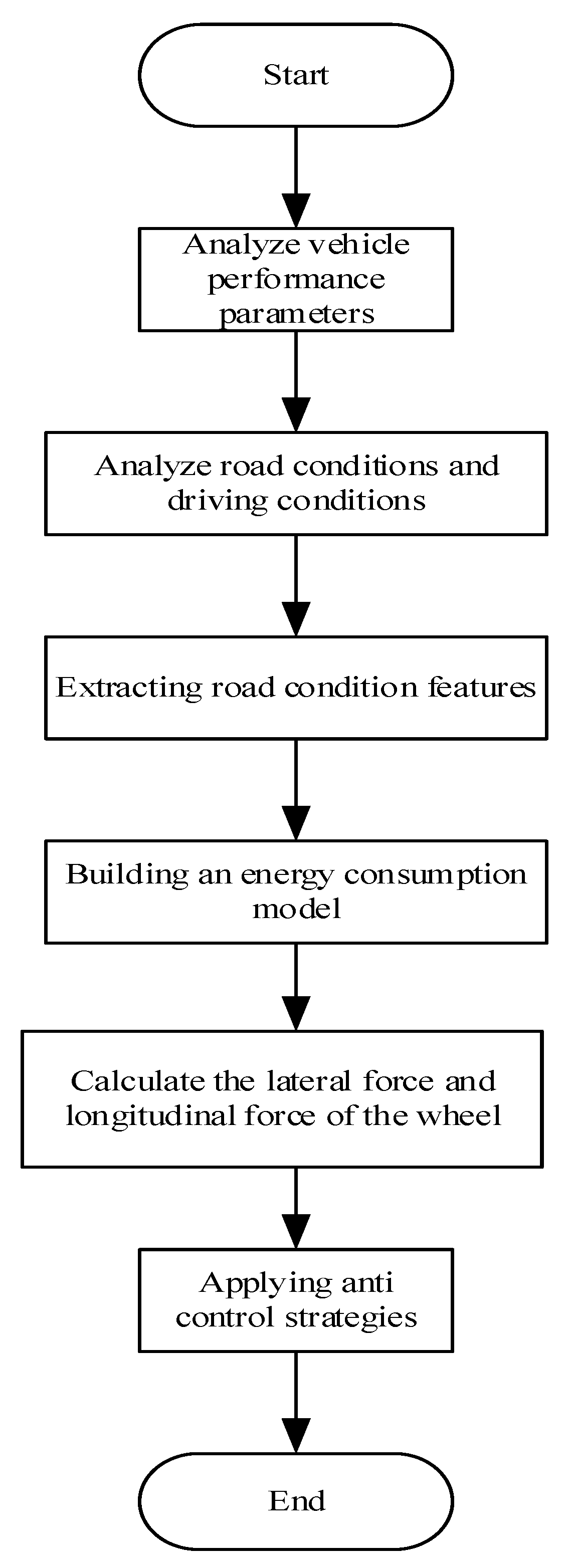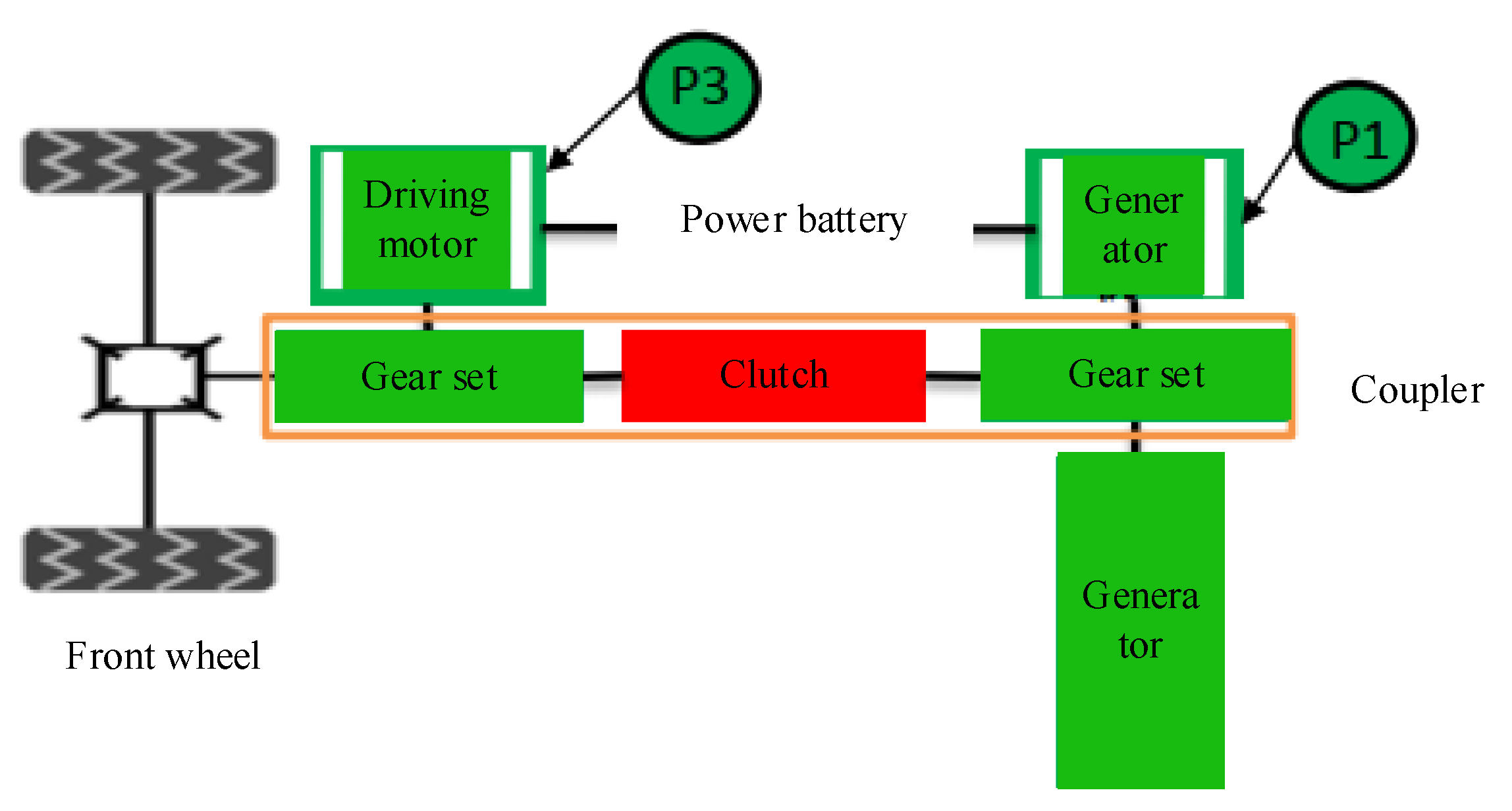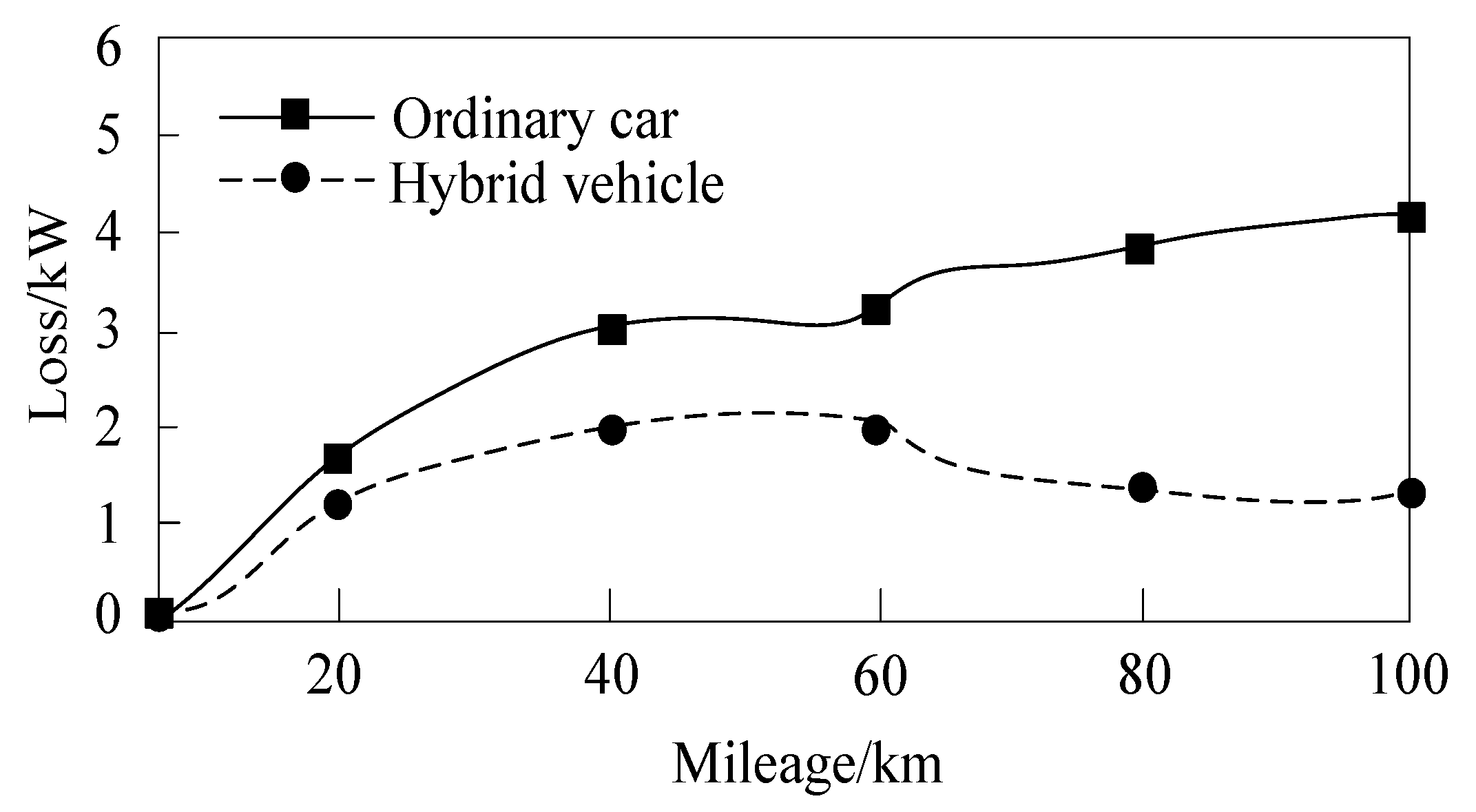Energy Consumption Prediction and Control Algorithm for Hybrid Electric Vehicles Based on an Equivalent Minimum Fuel Consumption Model
Abstract
:1. Introduction
2. Energy Consumption of a Hybrid Electric Vehicle under a Minimum Equivalent Fuel Consumption Model
2.1. Building a Minimum Equivalent Fuel Consumption Model
2.2. Energy Efficiency Measurement of a Hybrid Electric Vehicle
2.3. Energy Consumption Prediction Algorithm for Hybrid Electric Vehicles
2.4. Energy Consumption Control Algorithm for a Hybrid Electric Vehicle
3. Simulation Experiment and Results
4. Conclusions and Prospects
4.1. Conclusions
- (1)
- The driving energy consumption of a hybrid electric vehicle is small, and after the mileage exceeds 60 km, the power consumption is reduced to less than 1 kW. When stable power consumption is maintained, stable driving power for a vehicle can be provided.
- (2)
- The measurement results of the energy consumption and efficiency are largely consistent with the actual results, which shows that the measurement effect of the energy consumption and efficiency of the proposed algorithm meets the actual needs.
- (3)
- The prediction and control results for energy consumption are good, and the algorithm can quickly restore stability after short-term shocks, with good results.
4.2. Prospects
- (1)
- The research should analyze the dynamics of the core component—the dual planetary hybrid transmission—and establish a dynamic model of the transmission; integrate it with other component models, including the engine, power battery, dual motors, and vehicle longitudinal dynamic model; and establish a forward simulation model for a power split hybrid mining dump truck.
- (2)
- It is necessary to carry out bench tests and real vehicle tests to verify the control effect of the algorithm. At the same time, whether the model is in the loop or the hardware is in the loop, there is still a certain gap between the added noise signal and the real signal, and this needs further verification for the control strategy and control effect.
- (3)
- To design the energy management control strategy, it is necessary to fully consider factors such as battery aging and battery peak power, and it is necessary to optimize the design from multiple dimensions in combination with the power battery.
Author Contributions
Funding
Institutional Review Board Statement
Informed Consent Statement
Data Availability Statement
Acknowledgments
Conflicts of Interest
References
- Wolfram, P.; Hertwich, E.G. Potential Climate Impact Variations Due to Fueling Behavior of Plug-in Hybrid Vehicle Owners in the US. Environ. Sci. Technol. 2021, 55, 65–72. [Google Scholar] [CrossRef] [PubMed]
- Prajwowski, K.; Golebiewski, W.; Lisowski, M.; Eliasz, J. Road Test of Selected Electrical Parameters of the Hybrid Vehicle Accumulation System. IEEE Trans. Veh. Technol. 2021, 70, 203–211. [Google Scholar] [CrossRef]
- Xin, G.; Wang, P.; Jiao, Y. Noise nhanced quantum annealing approach and its application in plugn hybrid electric vehicle charging optimization. Electron. Lett. 2021, 57, 314–317. [Google Scholar] [CrossRef]
- Meli, M.T.; Leutcho, G.; Yemele, D. Multistability analysis and nonlinear vibration for generator set in series hybrid electric vehicle through electromechanical coupling. Chaos 2021, 31, 073126. [Google Scholar] [CrossRef] [PubMed]
- Hu, L.; Tian, Q.; Zou, C.; Huang, J.; Ye, Y.; Wu, X. A study on energy distribution strategy of electric vehicle hybrid energy storage system considering driving style based on real urban driving data. Renew. Sustain. Energy Rev. 2022, 162, 1–13. [Google Scholar] [CrossRef]
- Zhou, Q.; Li, Y.; Zhao, D.; Li, J.; Williams, H.; Xu, H.; Yan, F. Transferable representation modelling for real-time energy management of the plug-in hybrid vehicle based on k-fold fuzzy learning and Gaussian process regression. Appl. Energy 2022, 305, 117853. [Google Scholar] [CrossRef]
- Nie, Z.; Jia, Y.; Wang, W.; Chen, Z.; Outbib, R. Co-optimization of speed planning and energy management for intelligent fuel cell hybrid vehicle considering complex traffic conditions. Energy 2022, 247, 123476. [Google Scholar] [CrossRef]
- Roland, S.; Johannes, B.; Naim, B. Energy Management Strategy for Plug-in-Hybrid Electric Vehicles Based on Predictive PMP. IEEE Trans. Control. Syst. Technol. A Publ. IEEE Control. Syst. Soc. 2021, 29, 2548–2560. [Google Scholar]
- Li, S.; Gu, C.; Zhao, P.; Cheng, S. Adaptive energy management for hybrid power system considering fuel economy and battery longevity. Energy Convers. Manag. 2021, 235, 114004.1–114004.10. [Google Scholar] [CrossRef]
- Jia, H.; Tang, J.; Yu, Y.; Sun, Y.; Yin, B.; Zhang, C. Energy Management Strategy of Fuel Cell/Battery Hybrid Vehicle Based on Series Fuzzy Control. Int. J. Automot. Technol. 2021, 22, 1545–1556. [Google Scholar] [CrossRef]
- He, H.; Wang, Y.; Li, J.; Dou, J.; Lian, R.; Li, Y. An Improved Energy Management Strategy for Hybrid Electric Vehicles Integrating Multistates of Vehicle-Traffic Information. IEEE Trans. Transp. Electrif. 2021, 7, 1161–1172. [Google Scholar] [CrossRef]
- Wozniak, P.A. Hybrid Electric Vehicle Battery-Ultracapacitor Energy Management System Design and Optimization. Elektronika ir Elektrotechnika 2022, 28, 4–15. [Google Scholar] [CrossRef]
- Ma, Y.; Liu, Q. Real-Time Application Optimization Control Algorithm for Energy Management Strategy of the Hybrid Power System Based on Artificial Intelligence. Mob. Inf. Syst. 2021, 2021 Pt 9, 7666834.1–7666834.13. [Google Scholar] [CrossRef]
- Hemmati, S.; Doshi, N.; Hanover, D.; Morgan, C.; Shahbakhti, M. Integrated cabin heating and powertrain thermal energy management for a connected hybrid electric vehicle. Appl. Energy 2021, 283, 116353. [Google Scholar] [CrossRef]
- Merco, R.; Ferrante, F.; Pisu, P. A Hybrid Controller for DOS-Resilient String-Stable Vehicle Platoons. IEEE Trans. Intell. Transp. Syst. 2021, 22, 1697–1707. [Google Scholar] [CrossRef]
- Iqbal, M.; Ramadan, H.S.; Becherif, M. Health-aware frequency separation method for online energy management of fuel cell hybrid vehicle considering efficient urban utilization. Int. J. Hydrog. Energy 2021, 46, 16030–16047. [Google Scholar] [CrossRef]
- Sarvaiya, S.; Ganesh, S.; Xu, B. Comparative Analysis of Hybrid Vehicle Energy Management Strategies with Optimisation of Fuel Economy and Battery Life. Energy 2021, 228, 120604. [Google Scholar] [CrossRef]
- Taghavifar, H. Fuel cell hybrid range-extender vehicle sizing: Parametric power optimization. Energy 2021, 229, 120786. [Google Scholar] [CrossRef]
- Delprat, S.; Boukhari, M.R. Reducing the Computation Effort of a Hybrid Vehicle Predictive Energy Management Strategy. IEEE Trans. Veh. Technol. 2021, 70, 6500–6513. [Google Scholar] [CrossRef]
- Brunelli, L.; Capancioni, A.; Gonnella, P.; Casadio, R.; Brusa, A.; Cavina, N.; Caggiano, M. A Hybrid Vehicle Hardware-in-the-Loop System with Integrated Connectivity for eHorizon Functions Validation. IEEE Trans. Veh. Technol. 2021, 70, 4340–4352. [Google Scholar] [CrossRef]
- Chen, R.; Yang, C.; Han, L.; Wang, W.; Ma, Y.; Xiang, C. Power reserve predictive control strategy for hybrid electric vehicle using recognition-based long short-term memory network. J. Power Sources 2022, 520, 1–13. [Google Scholar] [CrossRef]
- Iqbal, M.; Laurent, J.; Benmouna, A.; Becherif, M.; Ramadan, H.S.; Claude, F. Ageing-aware load following control for composite-cost optimal energy management of fuel cell hybrid electric vehicle. Energy 2022, 254, 124233. [Google Scholar] [CrossRef]







| Reference | Research Findings | Research Limitations |
|---|---|---|
| [4] | Based on Lagrangian theory, a mathematical model for the electromechanical coupling vibration of the internal combustion engine and generator for a series hybrid electric vehicle was established. | The actual control effect of the model is inconsistent with the predicted results, and the energy control efficiency is low. The comprehensiveness of the model needs to be improved. |
| [5] | A global optimization method based on an energy allocation strategy is proposed that effectively solves the optimization problem of the cost and weight of the energy control. | The weight of the system equipment is large, the cost of operation and maintenance is high, and the output efficiency of the entire energy storage system is reduced. |
| [6] | A neural fuzzy system with real-time offline optimization results was constructed using K-cross allocation, which effectively improves the comprehensiveness of energy control by evaluating vehicle energy efficiency and setting penalty terms for battery energy use. | A large amount of resources need to be used to achieve offline optimization, and the offline optimization results are greatly limited by data and environment, which cannot fully reflect the actual situation, resulting in a poor control effect. |
| [7] | Joint control of the entire vehicle system avoids additional energy consumption in unexpected situations and improves energy efficiency and battery life. | In practical applications, there are significant limitations regarding computing resources and time that cannot guarantee the real-time running status of vehicles, resulting in poor practical application results. |
| [8] | This study proposes a vehicle baseline control and vehicle energy optimization management strategy based on the Pontryagin minimum principle that effectively controls the vehicle’s baseline driving and optimizes the vehicle’s energy control performance. | Without considering whether the equivalent fuel consumption is the minimum value for calculating the real-time energy consumption of vehicles, the optimization effect of vehicle energy configuration and management is not significant. |
| [9] | Propose an energy management strategy for supercapacitor hybrid power systems to address the issue of battery aging in hybrid electric vehicles. By developing a hierarchical energy optimization management framework, we can effectively improve the operational efficiency of automobiles and reduce battery aging costs. | Focusing solely on reducing economic costs without calculating the weight of vehicle energy consumption factors, it is impossible to monitor and predict vehicle energy consumption in real time. |
| [10] | This study proposes a fuzzy control strategy to control the load change rate of automotive battery systems. Effectively improving the durability of fuel cells and reducing vehicle operating costs. | The lack of actual simulation of car energy consumption resulted in control strategies being unable to adjust energy allocation and configuration strategies under different driving conditions, resulting in low energy utilization efficiency. |
| [11] | A physical network system based on an energy management strategy is proposed to address the issue of intelligent and electrified upgrades in hybrid electric vehicles. The deep reinforcement learning algorithm was applied to visualize and analyze the energy consumption parameters in dynamic vehicle systems, thus effectively improving the energy efficiency. | In the process of training network data, factors such as road conditions, driving speed, starting and acceleration, and the vehicle’s own energy supply and consumption were not comprehensively considered, making it impossible to control the energy consumption of hybrid vehicles in real-time. |
| [12] | In order to achieve the electrification of vehicle energy drive systems, a hybrid electric vehicle energy management system design is proposed to reduce the energy consumption levels and extend the service life of energy storage. | Unable to predict the future energy consumption of the vehicle before its operation, without controlling and optimizing the conversion and distribution of different energy sources during vehicle operation, energy utilization efficiency needs to be improved. |
| [13] | This study applies the open-circuit voltage method to estimate the power output of lithium-ion batteries in electric vehicles. The particle swarm energy management algorithm is applied to control the battery output power, allocate battery energy fuzzy quantities, effectively reduce energy consumption rate, and improve the real-time performance of vehicle energy management. | Without combining actual driving data to optimize the energy consumption structure of automobiles, only optimizing and adjusting the electric vehicles cannot achieve the synchronous development of automobile energy prediction and control. |
| Serial Number | Parameter Configuration | Value or Function |
|---|---|---|
| 1 | Vehicle mass (kg) | 1100 |
| 2 | Height of centroid (m) | 0.8 |
| 3 | Wheelbase (mm) | 2640 |
| 4 | Maximum power (kW) | 14 |
| 5 | Maximum speed (r/min) | 4620 |
| 6 | Pressure transducer | Real-time measurement of the pressure of the automobile wheel brake disc |
| 7 | Electronic brake pedal position sensor | Collect the position of the brake pedal and use it as an output |
| 8 | Engine−generator | 22/61 |
| 9 | Engine−(clutch)−differential | 50/61 |
| 10 | Driving motor−differential | 58/21 |
Disclaimer/Publisher’s Note: The statements, opinions and data contained in all publications are solely those of the individual author(s) and contributor(s) and not of MDPI and/or the editor(s). MDPI and/or the editor(s) disclaim responsibility for any injury to people or property resulting from any ideas, methods, instructions or products referred to in the content. |
© 2023 by the authors. Licensee MDPI, Basel, Switzerland. This article is an open access article distributed under the terms and conditions of the Creative Commons Attribution (CC BY) license (https://creativecommons.org/licenses/by/4.0/).
Share and Cite
Zhang, Q.; Tian, S. Energy Consumption Prediction and Control Algorithm for Hybrid Electric Vehicles Based on an Equivalent Minimum Fuel Consumption Model. Sustainability 2023, 15, 9394. https://doi.org/10.3390/su15129394
Zhang Q, Tian S. Energy Consumption Prediction and Control Algorithm for Hybrid Electric Vehicles Based on an Equivalent Minimum Fuel Consumption Model. Sustainability. 2023; 15(12):9394. https://doi.org/10.3390/su15129394
Chicago/Turabian StyleZhang, Qian, and Shaopeng Tian. 2023. "Energy Consumption Prediction and Control Algorithm for Hybrid Electric Vehicles Based on an Equivalent Minimum Fuel Consumption Model" Sustainability 15, no. 12: 9394. https://doi.org/10.3390/su15129394
APA StyleZhang, Q., & Tian, S. (2023). Energy Consumption Prediction and Control Algorithm for Hybrid Electric Vehicles Based on an Equivalent Minimum Fuel Consumption Model. Sustainability, 15(12), 9394. https://doi.org/10.3390/su15129394











